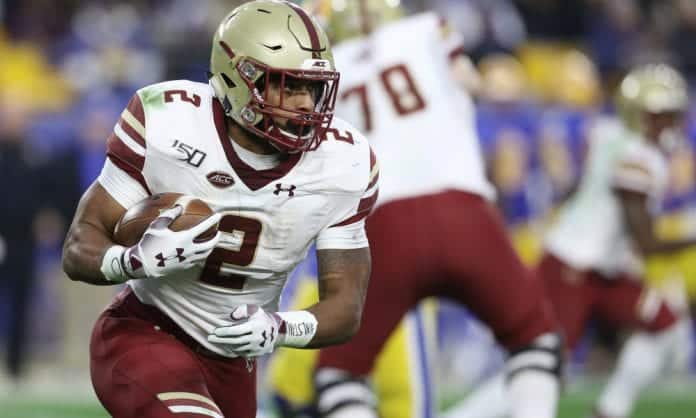The running back position was perhaps the biggest question mark of any position entering the 2020 NFL Draft. With no player a lock to go in the first round, the rest of the position was also accordingly in flux. Perhaps the most interesting question mark, both in NFL and dynasty value terms entering 2020, was Boston College’s, AJ Dillon.
Dillon came out of college having played in a run-heavy scheme before weighing 15 pounds more than the next biggest back at the combine. His weight had led to a wide variation in expectations surrounding Dillon’s value. Ultimately, he surprisingly went in the second round to the Green Bay Packers, but that selection raised as many questions as it answered for dynasty leagues.
[sv slug=mocksim]
AJ Dillon’s dynasty value heading into 2020
A lot more than meets the eye
When Dillon walks out onto a football field in 2020 he will raise a lot of eyebrows around the NFL. Standing at six feet tall and close to 250 pounds, many will question whether he has the ability to succeed at the running back position. Simply because he is wearing a Packers uniform, comparisons to Eddie Lacy will be drawn. However, that comparison is unfair on Dillon, who tested significantly better than Lacy.
Lacy entered the NFL with a relative athletic score of just 4.58, thanks to poor performances in the 40, vertical jump and 3-cone drill. In contrast, Dillon left the combine with a RAS of 9.16, with elite returns in the vertical jump and broad jump supported by a solid time in the 40. Instead of Lacy, the comparison that should be made for Dillon is Tennessee Titans’ running back, Derrick Henry. Henry’s numbers match Dillon’s from the height, through the jumps to the 40, even including the mediocre returns on the agility tests.
There is no questioning that Dillon will likely be a very effective short-yardage and power back, but can he be multi-dimensional? As Tony Pauline discussed in his scouting report, Dillon demonstrated limited speed and quickness on tape, as well as an inability to change direction quickly. However, he demonstrated just how productive he can be in college, carrying the ball 845 times for 4,382 yards and 38 touchdowns across his three seasons.
An immediate question that is asked about any back who looks like Dillon is around whether or not he can catch the ball effectively out of the backfield. While 21 receptions in three seasons may seem insignificant, there was promising development throughout his career. In his rookie season, he did not receive a single target, but in the following two years he had eight and 13 receptions, respectively. In his junior season, he took those 13 receptions for a whopping 195 yards, emphasizing what he can do when he gets the ball in space.
A question of playing time for Dillon
Trying to judge the value of rookie running backs can often depend on their playing time projection. Therefore, a second-round pick going into a situation where we saw a back put up a top-15 fantasy season in 2019 is not ideal. However, in a league where only five backs played more than 70% of their teams snaps and only nine more than 60%, committee situations are becoming more and more the new norm.
While Aaron Jones was one of those nine backs that played more than 60% of his snaps, he still surrendered more than 33% of snaps to Jamaal Williams. The committee situation in Green Bay drove owners of both Jones and Williams crazy last year, and now there is a third name in the mix in Dillon. While that situation may not be good for Dillon in the short term, there is more to be optimistic about looking longer-term.
Both Williams and Jones are entering the final year of their rookie deals in 2020 and could be on their way out the door next offseason. The Packers are a team that has tended to be hesitant in committing big money to their backs in the past, so there is a good chance that Dillon finds himself the number one option in the backfield come 2021.
How to value Dillon in rookie drafts?
Currently, Dillon is being selected late in the second round in standard leagues or early in the third round in Superflex formats. How each owner values Dillon will depend on their situation. If you need a back to contribute for you in 2020 then Dillon may not be the name you want to pin your hopes on. If you are selecting at the back end of a non-snake draft, then considering to take a running back to help you this year in the first and then passing up Dillon in the second would be the optimal option.
However, if an immediate contribution is not a need, then Dillon offers a wealth of potential. A big-bodied back who has demonstrated the ability to develop in the passing game, as well as put up big numbers on limited receptions could be a very valuable contributor. Add in that he could see both of the other major names in the Packers’ backfield leave next offseason, and the opportunity could be tremendous in 2021 and beyond.
In that situation, then Dillon could be worth a mid-second round pick, especially if your wide receiver situation is set. There is a big gulf in value at the running back position in that second-round region, and Dillon could be the perfect option to fill that back if you are able to sit and wait for him for a year.
Ben Rolfe is an editor and writer at Pro Football Network. You can find him on twitter @benrolfe15.

